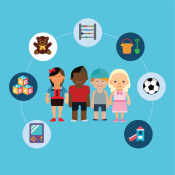Critical Information
The number of children ages 3 to 17 struggling with anxiety or depression rose by 1.5 million between 2016 and 2020. Educators trained in resilience will fortify their students and raise their potential for learning.
Two modes for promoting student resilience
Synchronous solutions…
include facilitated small group discussion, coaching, workshops, and more. Our unique web events include live group therapy, humor workshops to infuse fun into the classroom and even live events with comedians. Enjoy the video example.
Asynchronous solutions…
include on-demand video engagements on a range of topics from autism to dealing with difficult students. Faculty (and parents) can learn the rubric for developing greater resilience, will pass along this learning to students. Please enjoy this video montage on student engagement from our on-demand video library.
On-demand virtual engagements

Harassment in the Workplace Part III
Discriminating against people with disabilities is another form of workplace harassment, impacting both faculty and students. Learn about the law and ways to prevent personal and professional harm.

Helping Students Coming Out
One of the most dangerous times for a student is when they are considering their sexual orientation. Learn how to help support the student through this sensitive process.

Honesty at Work
Many leaders recognize the value of transparency. However, competing priorities and an excess of expectations can interrupt even the most determined leader’s efforts. Learn to align your aspirations.

How to Like the Unlikeable Student Part I
Difficult students can create chaos and stress in your classroom. Learn how to not only deal with this student but also build a relationship that brings collaboration and energy to your classroom.

How to Like the Unlikeable Student Part II
Difficult students can take up the majority of your energy in the classroom. Learn in-depth strategies to help you deal with these students.

How to Make Happy Parents
Unhappy parents can be a strong hindrance on your life and career. Learn a few easy ways to make parents happy and reduce the stress in your life.

Leadership in the Classroom Part I
This series prepares educators for this generation of students by looking at 7 key traits including the balance between like and respect. An essential learning engagement for managing students.

Leadership in the Classroom Part II
To be an effective teacher, it takes more than a strong knowledge base. Effective educators need to inspire young minds while holding them accountable to their potential.
Success Stories

"Whole School Health Through Psychosocial Emotional Learning highlights the importance of relationships, communication, and compassion for others. It presents a critical view in supporting, training, and retaining teachers through the lens of engaging and modeling behaviors that will help our rural students be better civic leaders and community members. My favorite quote from the book gives credit to the author's upbringing and modeling from his parents: 'We must experience the world through others so we can fully engage in educating all children. My father and mother modeled to me and my siblings how to experience the world through somebody else’s eyes, especially if their outer differences stirred up discomfort or displeasure, enriching all lives involved.' I recommend all leaders, teachers, and stakeholders secure their copy as they prepare for school."
Allen Pratt, Executive Director, National Rural Education Association (NREA)